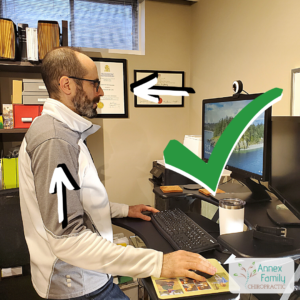Posture and Spinal Health
Imagine this: It’s been a long day of work and you’ve been hunched over, staring at a computer for hours. After sitting at a desk all day (for years!) you find that you have a sore back and neck.
Over time, you find that not only does the discomfort stay with you, but other issues have crept in to lower your quality of life. This is because posture is important in maintaining your muscular system, nervous system, and overall spinal health!
Poor posture puts the body in abnormal positions that the body has to hold by compensating. When we slouch over and don’t use our spine to support us, the body has to recruit muscles that will fatigue and tire over time.
This can lead to hyperactive muscles that can no longer relax and cause a lot of pain! In addition to muscular problems, it puts the vertebrae of the spine in abnormal positions which then irritates (not quite pinched) the nerve roots because they no longer have enough space! These irritated nerves hurt the nervous system and overall create dysfunction as the brain can’t communicate with the body as well.
There are three factors that influence posture:
- The vestibulocochlear system known as the ears
- The visual system of the eyes
- And receptors in the skin and joints called the somatosensory system
These systems tell the brain about where our head is, the environment around us, and where our body is. When our nervous system is blocked (i.e. irritation), the brain can’t communicate with these systems which leads to problems maintaining good posture.
Short term changes in posture can have long term effects. Bad posture will compress the lungs making it harder for them to expand and decreasing your breathing. This, in turn, can cause decreased pulmonary function. Poor posture will also put pressure on the vagus nerve which in turn could cause heart palpitations.
How We Can Improve Our Posture
The head normally weighs about 10-12 pounds. Flexing the head down just 15 degrees causes the head to weigh 27 pounds, 60 degrees makes the head weigh 60 pounds. This causes extreme stress on the spine and nervous system! Making sure that we have good posture while looking at our phones and reading books can make a big difference.






Click here to watch a brief video of Desk Posture Tips: https://www.instagram.com/p/CdgFkWmv8EL/
Fixing your posture doesn’t mean you have to go out and buy the most expensive ergonomic office equipment. A few lifestyle changes though can make a big difference!
- Set a timer every 30 min to go take a 5 minute break to stretch and walk (and if THAT sounds like too much, stop and dance your body and limbs around for 60 seconds!)
- See if your workplace can get you a desktop computer instead of a laptop
- Exercise regularly
- Have a designated work station that sets you up for proper posture while you work
Studies On Posture and Chiropractic
Studies on posture and Chiropractic have been published in multiple journals such as the “Journal of Physical Therapy Science.” A study done on a patient with “slouchy” hyperkyphosis of the spine showed how much chiropractic can improve posture. Over a series of 6 months, she received chiropractic adjustments, which restored her to the correct posture of her spine. As her posture improved, her headaches, back pain, and neck pain decreased.
When the spine is misaligned, it affects the sacrum, pelvis, and your entire legs. In 2015, a Korean study was published about patients who had survived a stroke that had hemiparesis, a condition where they have continued weakness on one side of the body. This weakness negatively affects their posture and ability to function.
By measuring their postural alignment through foot pressure and walking ability, they found that Chiropractic caused a significant improvement in their posture. This is just one of the ways that chiropractic and posture can be so effective in restoring health!
You may also be interested in: How Chiropractic Helps with Inflammation
Ready to have your nervous system function checked? Call 416-967-4466 for an appointment at our midtown Toronto office, or schedule online here: https://bookedin.com/book/annex-family-chiropractic
Here’s what our patients say:
“Dr Gelber and Grace are both fantastic. I started my healing journey with them over a month ago when I received a voucher from an existing patient for an initial health assessment. My friend and her family have been going here for many years, and she raved about it.
I just received my one-month treatment scan update, and can both see and feel the difference. My sleep is better, my headaches have been reduced, and my range of motion is improved. I am also a lot more mindful of my posture and this has made a difference.
Dr Gelber is incredibly realistic and upfront about what you can expect, what is expected of you, and how the whole process works. It is an investment in your long-term health, but it’s definitely worth it. If you are nervous at all about chiropractic care, give it a chance and come in with an open mind.” -Dayna
References:
- Surgical Technology International, October 2014. Kenneth K. Hansraj, MD, Chief of Spine Surgery, New York Spine Surgery & Rehabilitation Medicine, New York, New York
- Morningstar MW, Pettibon BR, Schlappi H, Schlappi M, & Ireland TV. (2005). Reflex control of the spine and posture: a review of the literature from a chiropractic perspective. Chiropractic & Osteopathy, 13(8), 1–17.https://eds.s.ebscohost.com/eds/detail/detail?vid=1&sid=6f456b1d-0533-431e-9a1f-75d9256bf0cd%40redis&bdata=JkF1dGhUeXBlPXNoaWImc2l0ZT1lZHMtbGl2ZSZzY29wZT1zaXRl#AN=106391288&db=ccm
- Harrison DD, Janik TJ, Harrison GR, Troyanovich S, Harrison DE, & Harrison SO. (1996). Chiropractic biophysics technique: a linear algebra approach to posture in chiropractic. Journal of Manipulative & Physiological Therapeutics, 19(8), 525–535. https://eds.s.ebscohost.com/eds/detail/detail?vid=2&sid=6f456b1d-0533-431e-9a1f-75d9256bf0cd%40redis&bdata=JkF1dGhUeXBlPXNoaWImc2l0ZT1lZHMtbGl2ZSZzY29wZT1zaXRl#AN=107318450&db=ccm
- Fortner, M. O., Oakley, P. A., & Harrison, D. E. (2017). Treating ‘slouchy’ (hyperkyphosis) posture with chiropractic biophysics®: a case report utilizing a multimodal mirror image® rehabilitation program. Journal of physical therapy science, 29(8), 1475–1480. https://doi.org/10.1589/jpts.29.1475 https://www.ncbi.nlm.nih.gov/pmc/articles/PMC5574330/
- Yang, D. J., Park, S. K., Kim, J. H., Heo, J. W., Lee, Y. S., & Uhm, Y. H. (2015). Effect of changes in postural alignment on foot pressure and walking ability of stroke patients. Journal of physical therapy science, 27(9), 2943–2945. https://doi.org/10.1589/jpts.27.2943 https://www.ncbi.nlm.nih.gov/pmc/articles/PMC4616131/
- https://www.betterhealth.vic.gov.au/health/conditionsandtreatments/posture
- Posture and Back help. Paying attention to posture can help you look and feel better. Harvard Women’s Health Watch (Report). August 2005. pp. 6–7.
- Robinson, Kenneth J.; Sanchack, Kristian E. (2019-02-25). Palpitations in StatPearls. StatPearls. PMID 28613787. Retrieved 2019-03-30 – via NCBI Bookshelf. CC BY-SA icon.svg This source from PubMed is licensed under the Creative Commons Attribution 4.0 International License.


